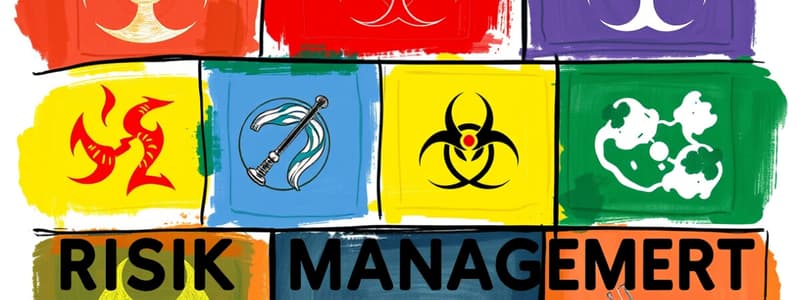Podcast
Questions and Answers
Describe the relationship between risk identification and project objectives.
Describe the relationship between risk identification and project objectives.
Risk identification involves determining potential risks that could negatively affect project objectives, assessing their likelihood and impact.
What characteristics should a risk possess to be considered within the scope of risk management?
What characteristics should a risk possess to be considered within the scope of risk management?
A risk should be somewhat likely to occur and have a significant potential negative impact on accomplishing the project objective.
Differentiate between types of hazards in the context of food safety.
Differentiate between types of hazards in the context of food safety.
Types of hazards in food safety typically include biological, chemical, and physical hazards that can contaminate food.
Explain the significance of common sense in risk identification.
Explain the significance of common sense in risk identification.
What are the key benefits of implementing risk management strategies?
What are the key benefits of implementing risk management strategies?
Define 'sanitation' in the context of food safety and explain its significance in reducing health risks.
Define 'sanitation' in the context of food safety and explain its significance in reducing health risks.
How does 'safety' differ from 'security' in a food service operation?
How does 'safety' differ from 'security' in a food service operation?
What role does 'hygiene' play in maintaining good health, and what practices are typically involved?
What role does 'hygiene' play in maintaining good health, and what practices are typically involved?
Explain the term 'toxin' and its potential impact on health.
Explain the term 'toxin' and its potential impact on health.
What does OHS stand for, and why is it important in the context of a food service environment?
What does OHS stand for, and why is it important in the context of a food service environment?
What are the key components involved in the risk management process?
What are the key components involved in the risk management process?
How does the definition of a hazard relate to food safety?
How does the definition of a hazard relate to food safety?
What distinguishes chemical hazards from other types of hazards?
What distinguishes chemical hazards from other types of hazards?
Describe the focus of ergonomic hazards in the workplace.
Describe the focus of ergonomic hazards in the workplace.
What is a psycho social hazard and its impact on workers?
What is a psycho social hazard and its impact on workers?
Describe the process that leads to food spoilage caused by microorganisms.
Describe the process that leads to food spoilage caused by microorganisms.
Explain how toxin-mediated infection occurs and its impact on human health.
Explain how toxin-mediated infection occurs and its impact on human health.
Differentiate between foodborne intoxication and foodborne infections.
Differentiate between foodborne intoxication and foodborne infections.
What are the key benefits of implementing risk management in a business?
What are the key benefits of implementing risk management in a business?
Summarize the risk retention approach in risk management.
Summarize the risk retention approach in risk management.
How does risk sharing function within project management?
How does risk sharing function within project management?
What is the purpose of a risk avoidance strategy?
What is the purpose of a risk avoidance strategy?
Explain how risk reduction strategies can benefit a company.
Explain how risk reduction strategies can benefit a company.
Define cross-contamination and explain how it may occur.
Define cross-contamination and explain how it may occur.
What constitutes potable water?
What constitutes potable water?
What is a foodborne illness and what causes it?
What is a foodborne illness and what causes it?
Differentiate between foodborne intoxication and toxin-mediated infection.
Differentiate between foodborne intoxication and toxin-mediated infection.
What role do consumers play in food safety?
What role do consumers play in food safety?
Explain the importance of risk management in food safety.
Explain the importance of risk management in food safety.
Identify the four types of foodborne illness.
Identify the four types of foodborne illness.
What are the typical symptoms associated with foodborne illnesses?
What are the typical symptoms associated with foodborne illnesses?
How do microorganisms contribute to food spoilage?
How do microorganisms contribute to food spoilage?
What preventative measures can be taken to avoid cross-contamination?
What preventative measures can be taken to avoid cross-contamination?
Flashcards are hidden until you start studying
Study Notes
Definition of Key Terminologies
- Risk: An uncertain event that may hinder achieving project objectives and includes potential hazards becoming reality.
- Risk Management: The process of identifying, assessing, and controlling threats to minimize their impact.
- Management: Organizing activities to achieve goals through the efforts of others.
- Hazard: Any condition or object with the potential to cause harm, injury, or property damage, particularly related to food safety.
Types of Hazards
- Physical Hazards: Foreign materials or objects that unintentionally contaminate food and pose risks to consumers.
- Biological Hazards: Microbial contamination that can lead to foodborne illnesses.
- Chemical Hazards: Substances that cause health issues when ingested or inhaled.
- Ergonomic Hazards: Related to workplace design that affects worker safety and comfort.
- Psychosocial Hazards: Factors affecting workers' psychological and social well-being, leading to stress-related issues.
Key Food Safety Terms
- Toxin: A poisonous substance often produced by living organisms.
- Safety: Ensures protection from harm and injury in food services.
- Security: Protection of property from damage or loss.
- Sanitation: Applying heat or chemicals to clean surfaces to eliminate 99.999% of disease-causing microorganisms.
- Hygiene: Practices to maintain cleanliness for good health.
- OHS (Occupational Health and Safety): Framework to ensure workplace safety and health.
Foodborne Illness Overview
- Food Spoilage: Changes in food's appearance, flavor, or texture due to microbial activity.
- Toxin-Mediated Infection: Illness caused by consuming food with harmful microorganisms that release toxins after ingestion.
- Foodborne Intoxication: Results from the consumption of food containing live disease-causing microorganisms.
- Foodborne Infections: Arise from eating food with live pathogens leading to illness.
Benefits of Risk Management
- Establishes safe and secure environments for staff and customers.
- Increases operational stability while reducing legal liabilities.
- Protects the organization from damaging events.
- Safeguards people and assets from potential hazards.
- Helps identify and manage insurance needs effectively.
Approaches to Risk Management
- Risk Retaining: Companies accept certain risks, balancing potential profits against risks.
- Risk Sharing: Distributing risks among project participants or partners to lessen impact.
- Risk Avoidance: Strategies aimed at minimizing threats to avoid negative consequences.
- Risk Reduction: Adjustments made to plans or processes to decrease potential damage from risks.
Studying That Suits You
Use AI to generate personalized quizzes and flashcards to suit your learning preferences.




